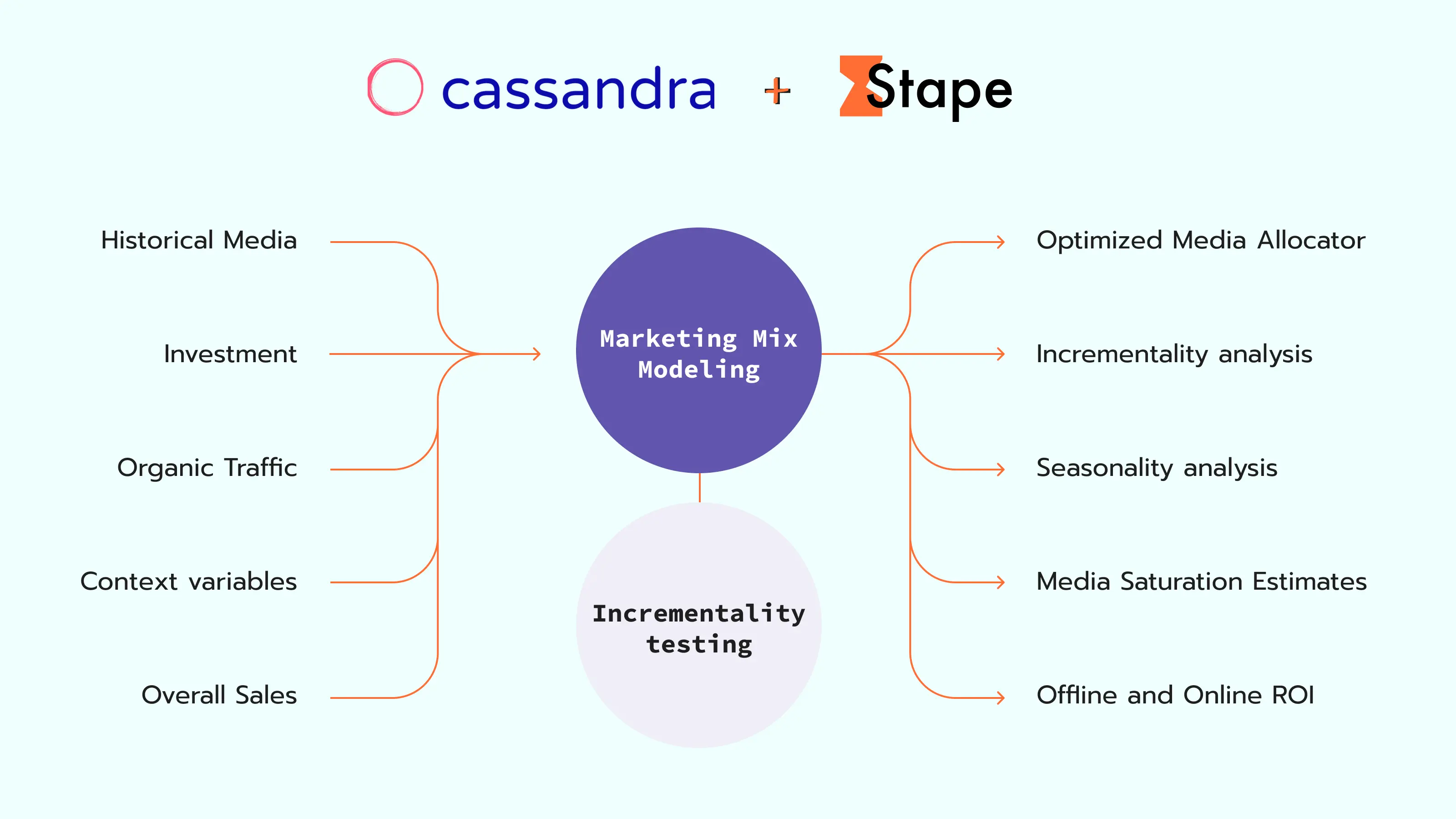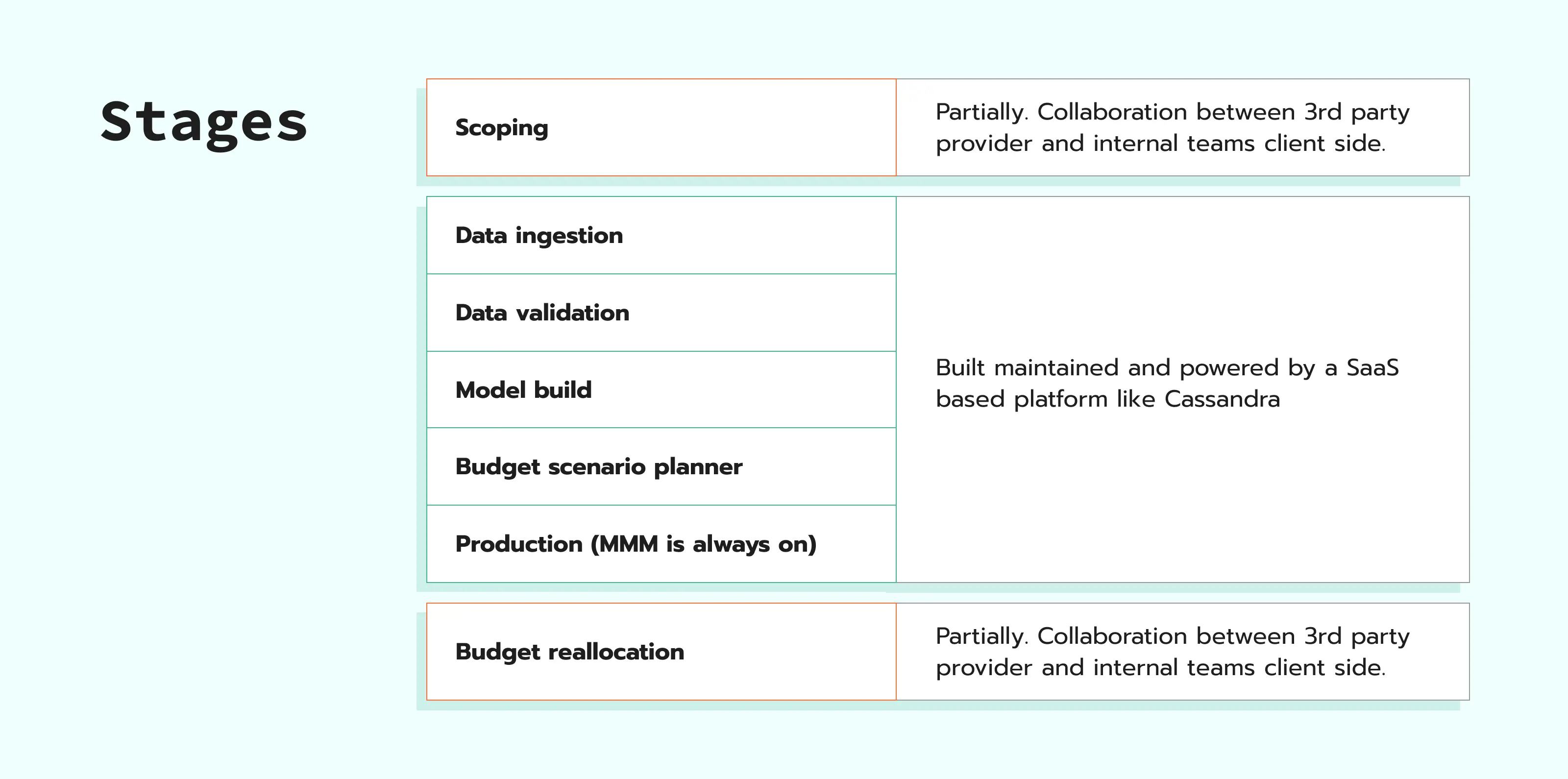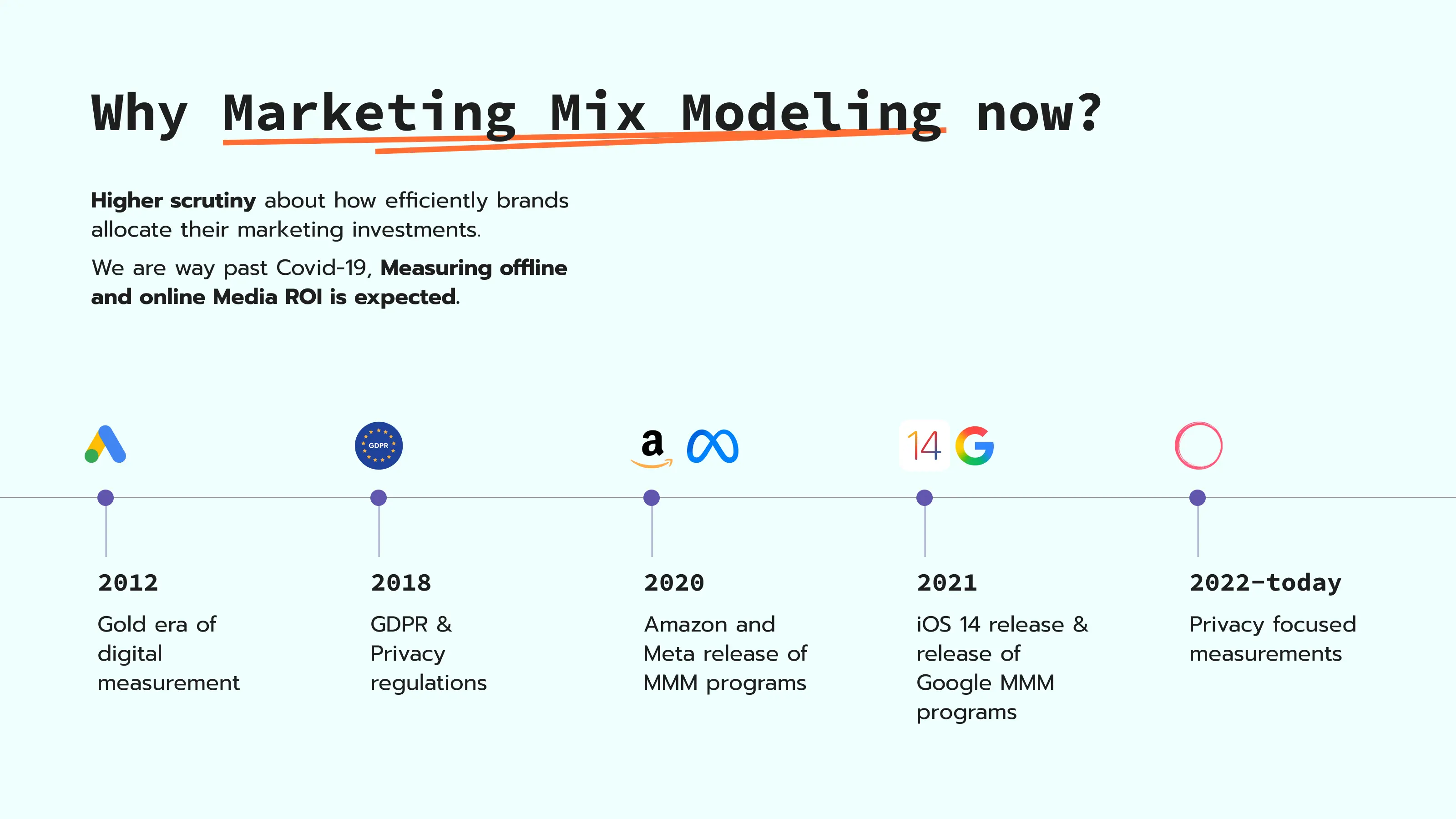Key takeaways
Marketing Mix Modeling, or MMM, is a method that measures how each marketing channel affects sales. It uses statistical models to separate what comes from marketing actions like ads or promotions from what comes from external factors such as seasonality or price shifts.
With MMM, marketers can:

MMM takes into account both media activities, like paid ads, and non-media factors, like promotions or seasonal peaks such as Black Friday. It usually uses 2–3 years of weekly or daily data and applies regression analysis to find links between actions and results. Regression helps identify how much each factor, like paid media, seasonality, or TV ads, contributes to business goals such as sales or new customers.
MMM can also show:
Each model's validity must be tested, often with "what-would-have-happened" scenarios, to check prediction quality.
Before building an MMM, define who joins the project and what goal it serves. Most companies use MMM to optimize their media mix, improving ROI without raising spend.
Even if the build stage seems detailed, modern software makes it faster. The focus should stay on high-quality input data, since it defines how reliable your model will be. After that, run the statistical checks to confirm reliability.
In the final stage, the model compares what's under your control (like ad spend) with what isn't (like seasonality). It then recommends how to allocate the budget in the smartest way to reach your chosen goal.

Marketing mix modeling is a reliable way to measure the real impact of marketing. It helps link investments to outcomes, even when cookies or user-level tracking are no longer available. Like any model, it has strengths and conditions for accurate results. Here’s what to know before running it.
Strengths
Conditions
Many marketers still see MMM as complex or only for big brands. In reality, it has changed a lot. Modern MMM tools are faster, easier to use, and work well next to platform data. Here are some common myths that often confuse people, and what's actually true.
Marketing mix modeling isn't a new trend at all. It has been around since the golden age of TV, when commercials ruled screens in the 70s and 80s. The idea itself isn't new. What changed is the technology and the environment around it.
Privacy laws like GDPR in the EU and Apple's App Tracking Transparency in iOS 14.5 made cross-site tracking difficult, pushing marketers to find safer ways to measure impact. Cheaper cloud storage and stronger computing now make MMM easier to run and far less expensive.
In the past, big consultancies such as Deloitte or Bain built MMM with private code. Now, with open source tools like Robyn by Meta (since 2021), Meridian by Google (since 2023), and PyMC-Marketing (since 2023), brands can build their own models in-house.
There are also SaaS platforms like Cassandra that offer ready-made, reliable MMM options at a lower cost.

MMM is now open to most marketing teams. Third-party SaaS tools like Cassandra now make setup simple and fast. What used to take months can be done in days thanks to cloud technology, which has made it affordable and light to manage.
Cassandra suggests using MMM if your brand meets these points:
Recent Cassandra case studies show ROI lift and cost reductions after MMM-guided changes and budget reallocations. Here are clear examples you can copy fast:
Boscolo Viaggi, travel.
Result: +45% revenue, +10% ROI with only +27% ad spend.
What they did: moved from GA last click to MMM, used seasonality and channel ROI to plan spend monthly.
Gina Tricot, fashion retail.
Result: +53% ROI MoM (month over month); total budget went down by 26%.
What they did: cut generic search and some influencer spend, shifted to Meta direct response campaigns and Performance Max based on diminishing returns and confidence intervals.
Treedom, subscriptions and eCommerce.
Result: −19% Cost per Order, −15% total ad spend.
What they did: stopped inefficient Performance Max and reinvested in better-performing media from the model.
What made it work for them
MMM gives a full-mix view, covers offline and online conversions, and is privacy-friendly. It replaces assumptions with ROI ranges and shows room to grow before you hit saturation. Then the clients can reallocate and measure again.
Following in more detail the steps described above, we see the right steps as follows:
Scoping. Agree with all parties on the data needed, the model approach, and actions for the next quarter.
Data ingestion. Collect 2 to 3 years if possible, weekly or daily. Include outcome KPI, media spend, organic, other marketing, and context variables.
Data validation. Check completeness and consistency. To reduce data gaps and non-reported conversions, set up server-side tagging on a cloud server. Client-side tracking alone often misses part of the data. Browser limits, blocked third-party cookies, and ad filters can stop events from being sent, so some conversions never reach analytics or ad platforms, making reports incomplete.
With server-side tracking, the data first passes through a cloud server before going to those platforms. This adds control and helps you share only the needed data, and keeps tracking compliant with privacy laws. It also improves accuracy because fewer browser issues interfere, giving MMM more complete inputs and making budget advice more reliable.
Setting up server-side tracking can be technical, but with Stape, the process becomes easier thanks to ready solutions that handle part of the configuration for you.
Model Build. Select or auto-select variables, adding holidays and seasonality, and setting the modeling window. You can also check multicollinearity and coverage alerts, then plug in geo experiment results when available. After validation and calibration, use R², NRMSE, RSSD, and MAPE to confirm accuracy.
Budget scenario planner. Walk through outputs; move budget according to specific goals and forecasted values.
Production. Set a weekly or monthly refresh. Define a clear decision process to keep meeting the commercial goal.
| This article was written in collaboration with Gabriele Franco, CEO at Cassandra. |
Comments